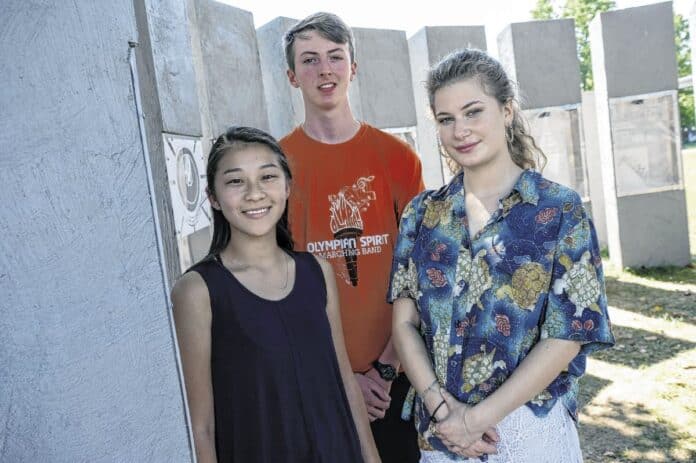
Local high school students who were part of the core team that built an architectural installation for Exhibit Columbus said the project was much more work than anticipated, but very worth it.
The installation, called DENCITY, is a Stonehenge-esque exhibit featuring 22 individual gray 8-foot-tall pillars arranged in a 20-foot-wide circle with a live tree at its midpoint.
Each column displays artwork by local high school students, laser cut and engraved on clear acrylic panels. Solar-powered lights were installed below each piece of art to illuminate the artwork, which depicts a student view of what represents Columbus.
Three members of the core team — Maika Shibata, 18, a Columbus North High School senior; Cameryn Kent, 17, a Columbus Signature Academy New Tech senior; and Chase Jones, 16, a Columbus East High School junior — recently reflected on their experience, including what they learned about the design process, construction techniques and how to work together.
[sc:text-divider text-divider-title=”Story continues below gallery” ]Click here to purchase photos from this gallery
“I had never really built off of other people’s ideas before,” Kent said. “We still had to edit our designs so much in the process of building it. I had never designed and built something before. It was just a really long process, and it was interesting to see how much you have to do to actually get something like this done and actually create it.”
Brainstorming and ‘arguments’
The students said they began planning and brainstorming ideas in September and October 2018. The students would meet weekly to exchange ideas and compare their own drawings of what they thought the project should look like.
“There were a lot of arguments with each other, definitely,” Kent said. “We would come every week and bring our own ideas and drawings and everything, and we’d talk about each individual design and pick the best idea from everybody.”
In January, when the students built a prototype of a pillar, the project started to take shape, the students said.
“That was when we just realized how much work it was going to be,” Kent said. “But that’s also when we saw what it was going to look like. It was just really cool to see.”
The students began constructing the 8-foot-tall pillars in mid-March and finished about a week before the opening weekend of Exhibit Columbus this month, Jones said.
Overall, Jones estimated that the core group of students spent, on average, around two to three hours per week for a year to work on the project, including taking entire days off from class and working over the summer.
“We met twice a week over the summer to finish construction and then there were a couple days where we took the whole school day to finish construction with help from the C4 construction trades classes,” Jones said.
The students said they also learned technical skills, including construction techniques.
“I didn’t know anything at all (about construction),” Shibata said. “I learned about the steps that you have to take in order to create what we built. We had to create the skeleton, the structure on the inside, and then we had to cut and shape the concrete board that we used.”
Kent, who also was involved in the construction process, quickly chimed in, describing much of the construction work the students did.
“We drilled the (concrete board) on,” Kent said. “Then we put drywall beads on that so we’d have defined corners and then we plastered concrete on it. Then we had to wait for that to dry. The concrete was probably the longest part, and then we painted it, drilled holes in it, put the aluminum in it. It was just a really long process, and I don’t think any of us had experienced something like that.”
The design of the installation was meant to reflect how Columbus is growing and changing, the students said.
“We wanted it to represent growth and urbanization in Columbus,” Cameron Swan, a North senior who was heavily involved in the project, said in an earlier interview. “If you look at a city from overhead, you see the center of the city where all the tall skyscrapers are, and as it moves out, the buildings get smaller and get residential. (The design of our project) invokes that as well … The goal is to invoke people to go in toward the center and view the artwork and move around.”
The finished product
In the run-up to the opening weekend of Exhibit Columbus, the students put in extra time to install their architectural installation at their designated location next to St. Peter’s Lutheran Church in downtown Columbus.
“We had all the pillars constructed in the shop a week out from the opening weekend, and there was a Friday when we had hired a forklift to come lift them up,” Jones said. “I took the whole day off from school and went (the exhibit site) in the morning and helped with installation, and it took the whole day. That was only the pillars and setting them down. We still needed to put in the metal framing on the inside and glass and the light installation and stabilize it. That took about three more days after school.”
Shibata said she worked every day that week to help install the exhibit to the point that she doesn’t remember how she felt when she saw the finished installation for the first time.
“I was just so tired that I don’t even remember what I thought (when I saw the finished installation) because I had worked every day after school for at least two hours,” Shibata said. “…The most exciting part was going after opening weekend when there were still people going to look at it, but also I had gotten rest. It was really cool to see families walking around and talking about the art and what they thought the exhibit represented. At night, it was really cool because it lights up the ground and the tree.”
Kent said it “was really nice to see,” but was “ a relief off your chest” because of all the work they had put in.
About 200 students from the three high schools contributed to the project in some form, though a core group of around seven students have been involved with all phases of the project from design, development and the construction of the prototype, the students said. The high school group was led by Darin Johnson, a North C4 instructor.
The artwork was provided by students in classes taught by Leslie Weaver, a North art teacher, and Robin Cain, a C4 instructor who teaches 3D visualization and animation, Johnson said.
[sc:pullout-title pullout-title=”About Exhibit Columbus” ][sc:pullout-text-begin]
Exhibit Columbus is an exploration of architecture, art, design that features a symposium and temporary installations that are inspired by the city’s heritage and “the role that a visionary community plays in growing a vibrant, sustainable and equitable city.”
The high school installation joins five featured Miller Prize Installations, five Washington Street Installations, six University Design Research Fellowships and a wayfinding and graphic design system by Thirst for a total of 18 temporary installations that will be open to the public until Dec. 1 around Columbus.
Visit exhibitcolumbus.org for more information.
[sc:pullout-text-end][sc:pullout-title pullout-title=”About the installation” ][sc:pullout-text-begin]
The students’ installation, called DENCITY, is a Stonehenge-esque exhibit featuring 22 individual 8-foot-tall pillars arranged in a 20-foot-wide circle with a live tree at its midpoint. Each column displays artwork by local high school students that was laser cut and engraved onto clear acrylic panels. Solar powered lights were installed below each piece of art to illuminate the artwork, which depicts what the students thought represented Columbus.
Visit exhibitcolumbus.org/2019-exhibition/high-school-design-team for more information.
[sc:pullout-text-end][sc:pullout-title pullout-title=”The high school team” ][sc:pullout-text-begin]
More than 24 high school students from Columbus East, Columbus North and CSA New Tech have contributed to DENCITY, though a core group of seven students have been involved with all phases of the project from design, development and the construction of the prototype, including:
- Cameron Swan, North
- Dylan Gahimer, North
- Aretha Landero Gonzalez, North
- Cameryn Kent, CSA New Tech
- Maika Shibata, North
- Chase Jones, East
- Peyton Donica, North
North C4 instructors Darin Johnson and Jeff Metz are co-sponsoring the project. Mike Metz, another North C4 instructor; Leslie Weaver, an art teacher at North; and Robin Cain, a C4 instructor at North who teaches 3D visualization and animation, have also been involved in the project.
All of the artwork for the installation was provided by students in art classes taught by Weaver and Cain.
[sc:pullout-text-end]




